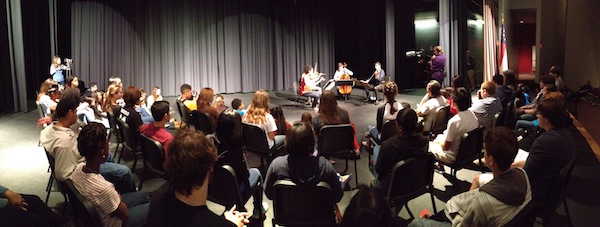
Detroit’s Sphinx Virtuosi heads to Macon
By Steve Murray, critic-in-residence with Art Matters: Engaging the Community through Embedded Arts Journalists
Holding the neck of his cello in hand, Karlos Rodriguez explained to his young audience where they might have heard “The Goldberg Variations” before.
You know the music during the opening credits for that gruesome, cannibal-psychiatrist TV series, “Hannibal”?
No response.
OK then, how about Dr. Lecter’s earlier, even ickier showcase, “The Silence of the Lambs.”
“The cage scene?” he prompted.
The memory of that movie’s bloody – if classically scored – sequence, depicting Lecter’s breakout, provoked an audible, squirmy Oooohhhhh” from the 60-plus teens, assembled in a semicircle around the musicians onstage at Howard High School’s theater Tuesday morning.
As part of a national tour that started in September and continues into November, Rodriguez and three colleagues of Catalyst Quartet performed selections and took questions from teacher John Sweat’s orchestra students. The group is the product of the Detroit-based Sphinx Virtuosi, an American ensemble of leading Black and string musicians, selected for their exemplary performances in the Sphinx Competition.
With funding from the John S. and James L. Knight Foundation, the quartet performed a free concert for the public Tuesday evening, followed by two, full-capacity performances for local students during the daytime on Wednesday.
Part of Sphinx Virtuosi’s mission is to dispel the idea that classical music is only for the cultural elite or for a particular racial demographic.
“Even among minority students who play string instruments themselves, they buy into the myth that it’s a white-person thing and it’s only for privileged people,” said Sweat, who teaches 80 students in his orchestra class and has been at Howard High School since it opened six years ago. “While the majority of my students don’t fall into the category of living at or below the poverty level – though we do have some in the school – it amazes me that a lot of students just see [classical music] as something for the upper crust.”
The students didn’t get any kind of snooty vibe from the musicians on Tuesday, a comfortable, casual foursome who took turns introducing themselves and chatting.
Violinist Jessie Montgomery composed the first piece they played, the aptly named “Strum” which showcased the pluck and sigh, the percolation then release of the stringed instruments.
In addition to Montgomery, a New Yorker, and Miami-raised Rodriguez, the ensemble included Paul Laraia, from New Jersey, on viola, and violinist Karla Donehew-Perez, born in Puerto Rico and raised in New Jersey.
They followed “Strum” with a “mini-medley” version of “The Goldberg Variations,” Johann Sebastian Bach’s masterpiece, adapted for strings from the original version, which was composed for a single harpsichord player.
When they finished, Rodriguez said, “It’s a cool piece, right?” Then he quizzed the kids: What was it originally commissioned for?
“A wedding?” one boy guessed.
“That would be a really long aisle,” Rodriguez said good-naturedly, explaining that the full composition takes about an hour to play. The answer: A rich man with insomnia commissioned the piece to help him go to sleep.
His personal harpsichordist’s last name? Goldberg.
For their last piece, violinist Donehew-Perez asked the students if any of them liked movies. Most hands shot up. The musicians launched into a nervous-but-soothing cradle-rock of the theme from “Mishima,” composed by minimalist Philip Glass for Paul Schrader’s 1985 movie.
“What does ‘minimalism’ mean?” Rodriguez asked when they finished.
“Doing the minimal?” one boy proposed.
That wasn’t too far off the mark. Rodriguez briefly explained what that musical genre entails, adding that Glass is one composer whose work is instantly recognizable after just a few notes. “That might be the mark of a great artist.”
The quartet took questions from the students at the end.
How many hours do they rehearse? Short answer: a lot, at least the same amount of time most people put into their 9-to-5 jobs.
What do they do when they’re not on tour?
“Watch Netflix!” Laraia said.
“Go to museums and clean the house – normal things,” Rodriguez said.
Thanking them for good questions, the Catalyst Quartet picked up their instruments and encouraged the students to ask them more, any time.
And here was final proof that, while classical music may be a venerable art form, its musicians are very much of the 21st century.
The best way to ask more questions, Rodriguez explained, is to “friend” the quartet on its Facebook page.
Photo by Cindy Hill
Steve Murray is critic-in-residence with Art Matters: Engaging the Community through Embedded Arts Journalists, a collaboration between the Macon Arts Alliance and Mercer’s Center for Collaborative Journalism. This project is supported in part by an award from the National Endowment for the Arts, Art Works. Matching funding provided by the John S. and James L. Knight Foundation. Journalists in the program will be spending time with artists and arts organizations in the Macon area through June, report what they discover, and foster ongoing conversations about the arts in Middle Georgia.
Recent Content
-
Artsarticle ·
-
Artsarticle ·
-
Artsarticle ·
